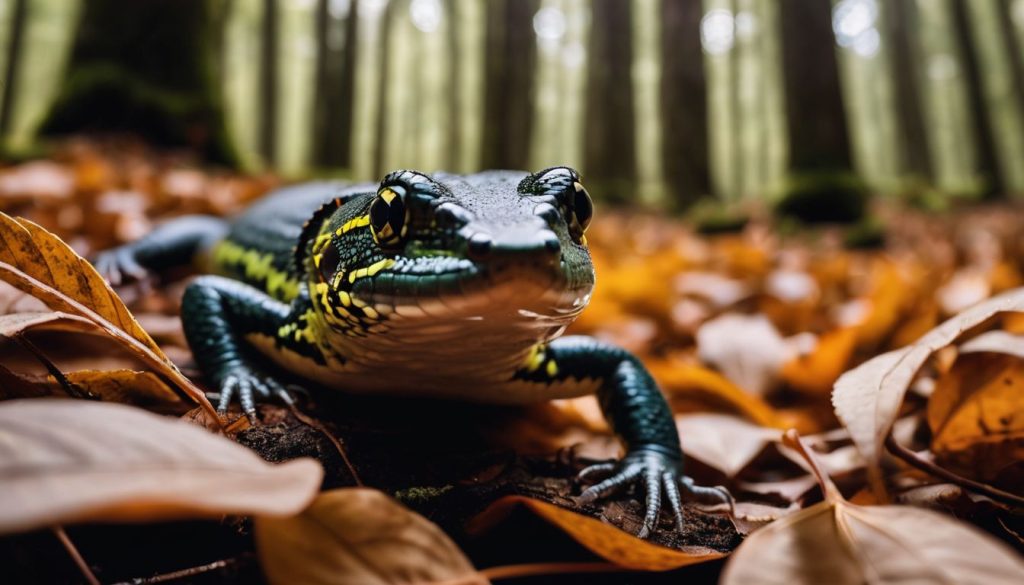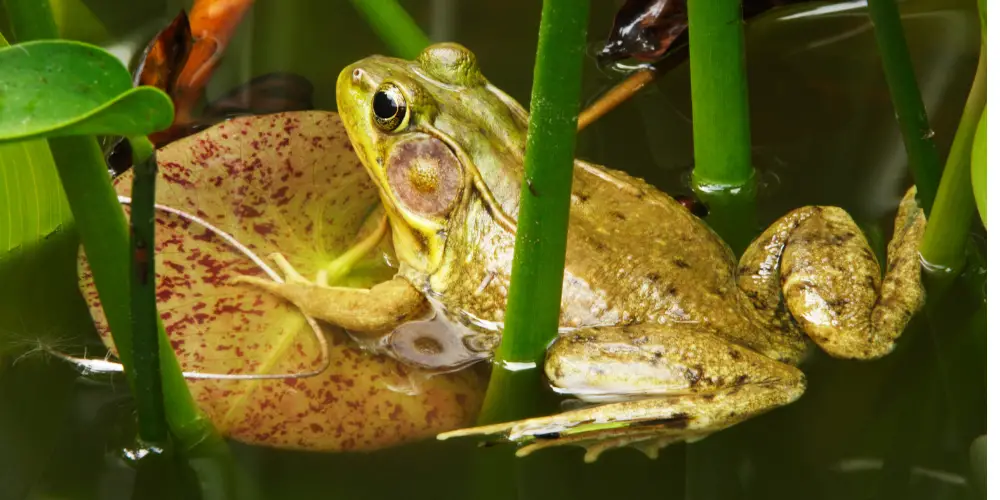Salamanders may seem secretive, but they’re critical to our ecosystems.
These tiny amphibians control pests, chowing down on mosquitos with gusto. This article will guide you through the why and how of safeguarding their precious homes.
Dive in to discover a world worth protecting!
Key Takeaways
- Salamanders are vital in ecosystems as pest controllers and environmental health indicators.
- They rely on specific habitats like wetlands and streams, making them vulnerable to habitat loss and pollution.
- Habitat destruction from urbanization, agriculture, and pollution threatens salamander populations globally.
- Conservation efforts by organizations and government agencies are essential for preserving salamander habitats.
- Restoration projects, watershed protection, and educating others are key to protecting salamanders and their habitats.
- Avoiding harmful chemicals and promoting public awareness are simple yet effective ways to help preserve salamander habitats.
- Preserving salamander habitats is crucial for maintaining biodiversity and ecological balance.
- Protecting their habitats contributes to a healthier and more sustainable planet for all species.
- The importance of salamander habitats extends beyond the survival of these amphibians to the overall health of ecosystems.
- Restoration efforts and conservation initiatives are essential for ensuring the long-term survival of salamanders and their habitats.
Understanding Salamanders
Salamanders are amphibians known for their smooth, moist skin and elongated bodies. They play a vital role in the ecosystem as predators of pests and serve as indicators of environmental health.
These unique creatures rely on specific habitats such as wetlands, streams, and forests for breeding and feeding.
Description, scientific classification, and behavior
Salamanders are fascinating amphibians with slender bodies, short legs, and long tails.
Their skin is moist and permeable, allowing them to absorb water and breathe through their skin.
This unique feature also makes them extremely vulnerable to environmental changes such as pollution. Classified under the order Urodela, salamanders vary in size from tiny species just a few centimeters long to giants exceeding two feet.
These creatures display remarkable behaviors; for instance, they are known for their ability to regenerate lost limbs – a feat that has captivated scientists.
They hunt pests effectively by consuming insects like mosquitoes, contributing to ecosystem health.
Living in near-water environments or on damp soil, they rely on specific habitats for survival.
Moving seamlessly into the next topic of discussion, these specialized habitats are crucial for the survival of salamander populations worldwide.
Their reliance on specific habitats
Salamanders depend on specific habitats for their survival, preferring moist environments near water sources such as streams or wetlands.
The presence of abundant vegetation and microhabitats is crucial for shelter and protection.
These amphibians are sensitive to changes in their surroundings due to their permeable skin, making them vulnerable to pollution and habitat destruction.
Restoring stream ecosystems and protecting watershed areas are vital in providing suitable habitats for salamanders, preserving the delicate balance necessary for their existence.
Due to their reliance on specific habitats, salamanders serve as indicators of environmental health within these ecosystems. Their diminishing populations reflect the impact of human activities on these unique environments.
Threats to Salamander Habitats
Human interference and pollution threaten salamander habitats, leading to habitat loss and destruction. It is crucial to address these issues to protect the unique habitats that salamanders rely on for their survival.
Habitat loss and destruction
Salamanders face a significant threat due to habitat loss and destruction. Urban development, deforestation, and agriculture are major contributors to the destruction of their habitats.
The loss of these crucial environments limits the salamander’s ability to find food, shelter, and breeding sites.
Pollution from industrial activities and agricultural runoff further exacerbates this issue by degrading water quality and contaminating natural habitats essential for salamanders.
Efforts to preserve and restore these vital ecosystems continue through conservation organizations’ initiatives and government intervention.
Restoring streams, protecting watershed areas, and enacting legislation that preserves critical habitats are essential steps in mitigating the impact of habitat loss on salamander populations.
Human interference and pollution
Human activities such as urbanization, agriculture, and construction projects have destroyed salamander habitats. Pollution from industrial waste, pesticides, and fertilizers has also taken a toll on these amphibians.
As a result, salamanders are facing habitat loss and fragmentation due to human interference in their natural environments. This disruption is causing detrimental effects on their populations across various species.
Pollution poses a significant threat to salamanders because of their sensitive skin that easily absorbs toxins present in polluted water or soil.
Additionally, deforestation and land development increase runoff into waterways where salamanders live.
Conservation Efforts
Various organizations and government agencies are making conservation efforts for salamander habitats.
These include habitat restoration projects aimed at preserving the unique ecosystems that salamanders rely on for survival.
Organizations and government agencies
Various organizations and government agencies play a crucial role in protecting the unique habitats of salamanders by implementing conservation efforts and supporting habitat restoration projects.
These efforts contribute to preserving biodiversity and ensuring the survival of endangered species like salamanders. Here are some key organizations and government agencies involved in safeguarding salamander habitats:
- The U.S. Fish and Wildlife Service (USFWS) provides vital support for salamander conservation through habitat protection measures, research initiatives, and public outreach programs.
- The Nature Conservancy, a leading environmental organization, actively engages in habitat restoration projects to create suitable environments for salamanders.
- The Environmental Protection Agency (EPA) implements regulations and guidelines to minimize pollution and protect water quality, directly benefiting the habitats of salamanders.
- Amphibian Ark, an international organization dedicated to amphibian conservation, collaborates with local governments to establish protected areas for salamanders and other amphibians.
- The World Wildlife Fund (WWF) partners with local communities and governments worldwide to preserve critical habitats essential for the survival of endangered species like salamanders.
- State wildlife agencies work closely with local communities to enforce regulations that promote responsible land management practices, ultimately benefiting the habitats of salamanders.
- Wildlife rehabilitation centers play a pivotal role in rescuing and rehabilitating injured or displaced salamanders, contributing to the preservation of their habitats.
- The National Park Service (NPS) manages diverse ecosystems that serve as important habitats for various species, including salamanders, ensuring their long-term sustainability.
Habitat restoration projects
Protecting salamander habitats is essential for preserving their biodiversity and ensuring their survival.
Habitat restoration projects are crucial in creating suitable living conditions for these amphibians. Here are some key initiatives:
- Restoration of streams and wetland areas, providing vital water sources and shelter for salamanders.
- Watershed protection safeguards the quality of water bodies where salamanders reside, ensuring a healthy environment.
- Stream restoration projects recreate natural flow patterns, aiding in the regeneration of aquatic habitats crucial for salamander populations.
- Protection of critical breeding grounds and nesting sites to support endangered salamander species’ reproduction and population growth.
- Ecosystem preservation efforts that focus on maintaining the balance and functionality of habitats where salamanders play a vital role.
Simple Steps to Protect Salamander Habitats
Avoid using harmful chemicals in your yard, such as pesticides and herbicides. Educate others about the importance of salamander habitats and their role in maintaining ecosystem balance.
Avoiding harmful chemicals
Minimize pesticides and herbicides in your yard to protect salamander habitats. Opt for natural pest control methods, such as attracting insect-eating birds and using organic fertilizers.
When maintaining your car, be cautious about oil spills and chemical leaks that could contaminate nearby water sources where salamanders live.
Use eco-friendly cleaning products to reduce harmful chemicals from entering aquatic environments.
Avoid dumping unused chemicals down drains or into stormwater systems, as these can end up in water bodies where salamanders reside.
Properly dispose of household chemicals at designated collection sites or hazardous waste facilities to prevent pollution of their habitats.
Educating others about salamanders
Educating others about salamanders is crucial in raising awareness about preserving their habitats.
People should be informed that salamanders are an indicator species, meaning their presence or absence can indicate the health of an ecosystem.
Educating communities and local authorities about the significance of maintaining healthy salamander habitats can promote better conservation efforts and reduce human impact on these delicate ecosystems.
Increasing public awareness can help minimize destructive behaviors such as habitat destruction and pollution threatening salamanders’ survival.
Educational initiatives should emphasize how protecting salamander habitats benefits these unique amphibians and overall biodiversity and ecological balance.
Conclusion – The Importance of Preserving Salamander Habitats.
Preserving salamander habitats is crucial for maintaining biodiversity and sustaining ecosystems. Protecting these unique habitats safeguards the survival of salamanders and the balance of nature.
Restoration efforts and conservation initiatives are vital in ensuring these amphibians have a safe environment to thrive.
By taking simple steps to protect their habitats, we contribute to preserving the delicate balance of our natural world.
As we strive to protect endangered species like salamanders, we ultimately work towards a healthier and more sustainable planet.
FAQs
1. Why is it important to protect salamander habitats?
Protecting the unique habitats of salamanders is crucial because it helps preserve biodiversity and prevents the extinction of these special amphibian species.
2. What are the threats to salamander habitats?
Threats to salamander habitats include pollution, deforestation, climate change, and development which can lead to endangered species conservation issues.
3. How does wildlife protection contribute to conserving amphibians like salamanders?
Wildlife protection efforts focus on creating laws and establishing reserves that safeguard endangered habitats from harm, directly supporting amphibian conservation.
4. Can we help in preserving Salamander Biodiversity at home?
Yes! People can aid in preserving Salamander biodiversity by advocating for wildlife conservation, supporting habitat restoration efforts, and being mindful of their environmental impact.
5. What actions are taken for habitat restoration for salamanders?
Habitat restoration for salamanders includes cleaning water bodies, planting native vegetation, controlling invasive species, and restoring wetlands that support their ecology.



